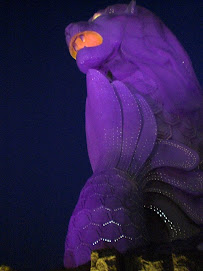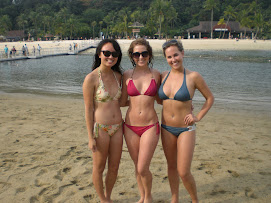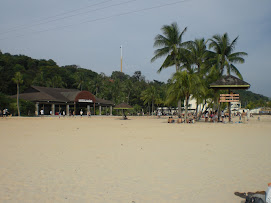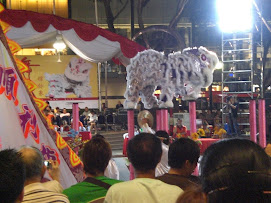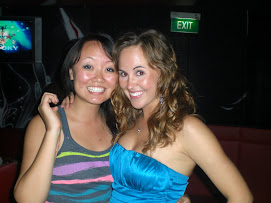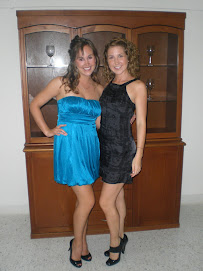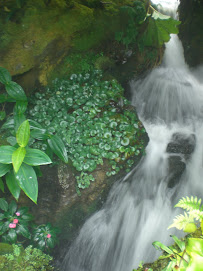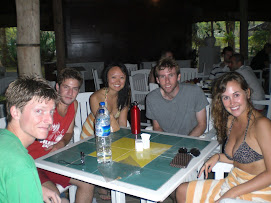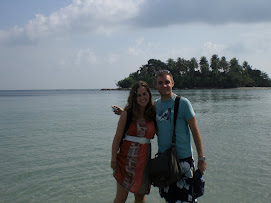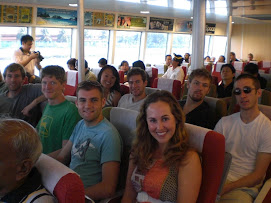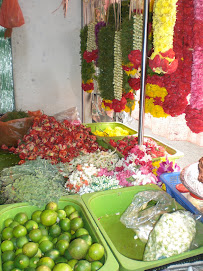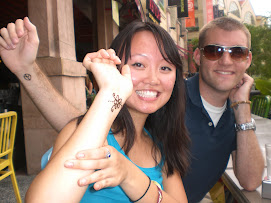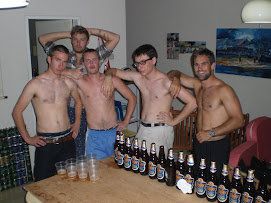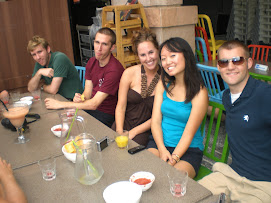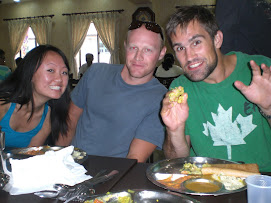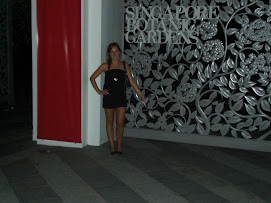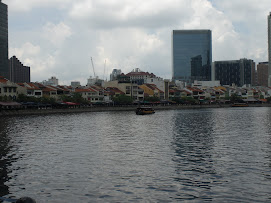Stephanie grabbed my hand and asked nervously, “Ready?” Not really, but what else could I say but “Yes”, we didn’t have any other option. There was no time to hesitate. We would be in big trouble if we did. They timed it just right so they wouldn’t hit us. We’d feel their exhaust hot on our legs as they went by. So we closed our eyes, held our breath, and walked into the lion’s den.
The “lion’s den” in this case being not a literal cave with a hungry lion waiting inside, but instead, an even more deadly flood of speeding, swerving pick-up trucks, buses, tuk-tuks, and mopeds with whole families crammed onto them babies and all on one of the busiest streets in Phnom Penh, Cambodia. (Stephanie and I actually had a running bet going about how many people could fit on a moped. (Answer: We saw five at one point).) I had been here for nearly four hours, and I still wasn’t exactly sure what side of the road they drove on. I had a sneaking suspicion that it didn’t really matter.
But, for the sake of suspense (I know you’re all wondering whether I made it across the street alive), let’s rewind a few weeks. To be completely honest, I don’t even really remember them. It is sort of a blur of lesson planning for hours on end sustained by Venti Starbucks coffees….black, sitting though endless planning and best practice meetings sustained by bad instant coffee…black, and a staff dinner and PiA party sustained by and recovering with wine…white AND red.
For the past two weeks, I have been working on the lesson skeleton, aka scheme of work or SOW, for my two classes next year. I will be teaching the two secondary two normal academic classes. Secondary two is the equivalent of our eighth grade, and the normal academic students are right between the express level and normal technical as far as ability goes according to the ranking system. After creating my SOW, revising my SOW, and rearranging my SOW, I’m still, today, working on my SOW and will be throughout Christmas break. That’s what happens when you get a new teacher who also happens to be an extreme perfectionist working on SOWs I guess. But, regardless of the insane amount of work, I’m really excited to start teaching my own classes in January. I will also be helping the music classes add a movement/dance component to the syllabus, and I’m choreographing the school’s musical as well. I consider myself truly lucky to be doing things I excel at and enjoy for my job, not-to-mention my job allows me to pop over to Cambodia for the weekend.
Amidst the craziness of lesson planning and staff retreats, I also had the opportunity to attend an end of the year banquet with my colleagues, the theme of which was “Kampong Glam”. We all dressed in traditional Malay costumes (mine borrowed of course), and enjoyed, what else, but a huge dinner. The dinner took the format of a Chinese wedding feast, complete with eight courses, and a presentation of the food that included flashing lights, dancing waiters, and cheesy “wedding” songs. Notable among the many courses was squid, sushi, warm almond flavored soup for dessert, and shark’s fin soup. I had a difficult time eating the shark’s fin soup, as after one bite my mentor informed me that hunter’s illegally hunt the shark, cut off their fins, and throw them back into the ocean to die. Ok, so I was under-exaggerating when I said I had a hard time eating it after that, I mean I could barely hold back the vegetarian-animal-rights-activist-in-me tears.
The problem is that old traditions die hard. Shark’s fin soup has been an integral part of Chinese wedding celebrations forever, and as long as there is demand, there will be supply. Shark’s fin soup aside though, it was a really enjoyable evening made even more exciting by the various dances we were made to choreograph and perform with our table-mates. Watching a bunch of your colleagues make fools of themselves…now that’s entertainment.
On the evening following my teachers’ banquet, I attended the launch party for the PiA Singapore-based office. It was a lovely evening at a quaint wine bar during which I served wine and smoozed with the big wigs for the first half, and drank wine and chatted about winter holiday plans with my fellow PiAers for the second half of the evening. It still amazes me that combined my friends and I will see Beijing, Cambodia, Nepal, Laos, Vietnam, Thailand, Bali, and India all in December. And, Stephanie and I launched the excursions with our trip to Cambodia this past weekend.
We arrived in the insanity that is Phnom Penh, Cambodia’s capital city, on Saturday morning at 7:45 a.m., and thus commenced our street-crossing extravaganzas. After checking into our lovely and conveniently located hostel, we literally ran across the street to the Royal Palace for our first tour of the day. Cambodia is officially known as the Kingdom of Cambodia, and, while there is a king, he is primarily a symbolic figure who acts as Head of State today, with the government being a Parliamentary Representative Democracy. Regardless of his power or lack-there-of, our tour guide informed us that the king is a former ballet dancer and a bachelor, both of which make him ok in my book. Despite our valiant efforts, Stephanie and I were unable to catch a peak of the king, though the blue flag flying high above the daffodil-colored walls told us he was in residence. (Side-note: He’s also in his 50’s, so sorry for those dreaming of a young, dancing Prince Charming).
First on the tour of the palace grounds was a strangely beautiful tree from which flowers are taken to make malaria medicine. The bark is twisted and ugly, yet the most enchanting flowers emerge from the strange branches; a lovely symbol of the healing process that Cambodia is undergoing since the reign of the Khmer Rouge (more of this to come).
We then followed our guide to the extravagant Throne Hall, which was first built of wood in 1869 and redone as it is today in 1917. Royal coronations and weddings still take place in the building, the floor of which is covered in a huge one-piece carpet that was a gift from China. The hall also holds the pure gold busts of kings of the past, which escaped the Khmer Rouge because they were buried in the mountain region along with other treasures before the king himself escaped to Beijing. From the Throne Hall we could see the king’s residence and the Moonlight Pavilion, on which the Royal Cambodian Ballet, and sometimes, the king himself, still perform.
We walked through the ground’s gardens, stopping occasionally to ogle the stupas, which are Buddhist burial places for ashes, and the elephant statues. In the past, the king rode white elephants during parades and festivals etc., but because the Khmer Rouge killed the country’s population of white elephants, the king is now carried by his staff during such occasions. Despite the fact that they were all destroyed, the white elephant is still a prominent symbol in Khmer art and architecture. This, again, I believe is symbolic of the Cambodian peoples resilient spirit.
The final stop on our tour was the Silver Pagoda, named such because of the more than 5,000 silver tiles covering its floor. The locals also refer to the pagoda as the Emerald Buddha, because of a beautiful emerald Buddha statue that sits high atop a shrine near another Buddha statue encrusted with 9,584 diamonds. These treasures, and many others found inside the Silver Pagoda, were also buried in the mountains during the Khmer Rouge’s reign of terror and thus escaped from being destroyed.
Interested to know more about the Khmer Rouge, Stephanie and I grabbed a quick lunch on a balcony overlooking the river, before heading to S21, a Khmer Rouge “museum.” I put the word museum in quotes, because a visit here feels more like a visit to a concentration camp in Germany than to a museum. This former high school was converted into a prison and torture chamber by the Khmer Rouge from 1975-1979. Small cells still contain the Khmer Rouge’s instruments of torture, blood stains are visible on the walls, and pictures of the “inmates” hang in a display room, faces gaunt from starvation and eyes wide with fear or half-closed in defeat; men, women, children, even babies, all staring blankly into a camera held by the people that will eventually kill them.
The leader of the Khmer Rouge, Pol Pot, came to power in a situation similar to that in which Hitler did; a country in shambles (because of the Vietnam war) and in need of strong leadership. Soon after entering Phnom Penh to wild cheers from the people, Pol Pot evacuated the city dwellers to the countryside in pursuit of a “purer” agrarian society. His army captured, persecuted, and killed intellectuals, doctors, teachers, any one who was educated and did not hide it or anyone who spoke out against the government. Of the 20,000 prisoners who came to S21 during the Khmer Rouge’s reign, a mere seven survived.
Stephanie and I spend a silent four hours walking the halls, our footsteps hauntingly echoing in the former torture chambers, reading, with growing horror and thickening sadness, the stories of the prisoners and Khmer Rouge leaders themselves. I’m still shocked by how little I knew about the history of the Khmer Rouge. Even more shocking to me though, many of the former leaders and murders who worked under the Khmer Rouge lived freely and were not charged for their crimes until 2007, nearly thirty years after these atrocities against humanity occurred. All I could say as I left was to echo the pleas of those who survived the reign of terror; what happened to “never again?”
After our visit to S21, the lingering effects of the Khmer Rouge’s reign of terror became acutely apparent. I have never seen such a young society. There are so many young families and children, primarily due to the fact that such a large portion (over three million) of the country’s population was killed in the 1970s. In addition, nearly 90 percent of Cambodia’s people are farmers. Yet, the country has started to rebuild itself, a beautiful testimony to the resilience of the human spirit. In a country still struggling to get back on its feet, I have never seen so much blatant happiness; yelling, laughing, honking, winking, begging, hugging, living and most of all, simply smiling. As our Angkor tour guide would tell us the following day, “We are told to smile like the Buddha.”
After our visit to S21, Stephanie and I needed to feel and see this resilience again, and what better way, than to put our own lives at risk to cross the street to a market. We wandered through the crowded alleyways haggling for scarves, street art, and trinkets, all the while trying to avoid stepping on the fish heads that the vendors were chopping off right on the street and the pig’s hooves that the woman was slicing off the pig’s leg on top of that table over there (over there because we decided not to get too close).
Following our colorful and exciting market experience, we met Stephanie’s friend Emma and several of Emma’s friends for a traditional Khmer meal. The restaurant is run by an organization that takes kids off the street and trains them to be waiters/waitresses, hosts, and cooks. We then went out to experience a bit of the small but lively expat nightlife of Phnom Penh. Business men and women in suits at a velvety bar stands in stark contrast to the small barefooted boy, who followed me for nearly two blocks today trying to convince me to eat at his family’s food stall by pointing at his mouth and saying “num nums.” (Another side-effect of the Khmer Rouge is the lack of a middle class in Cambodia. The people are either very wealthy or very poor. And, unfortunately, the very wealthy are often not Cambodians themselves.)
On Sunday morning, Stephanie and I were once again up with the sun as we had to catch a bus to Siem Reap, which is the town near the Angkor temples. We thought we could probably sleep on the five hour ride to Siem Reap. We thought wrong. The “highways” in Cambodia are not exactly like the highways in the U.S. or Singapore to say the least, and we were lucky if we went five minutes without bouncing into and right back out of a giant pot-hole. In addition, the bus drivers drive on the highway similarly to the way they drive in town. Enough said.
Despite all this, the ride was oddly charming. The bus wound through, and sometimes into, rice fields as far as the eye could see. Most men, women, and children harvested the rice by hand, while the lucky ones drove the family’s cow through the fields. Occasionally, we came upon a village with houses sitting on stilts with woven roofs and no doors. Half-naked children ran in and out of the small ponds playing rope games while fathers gave the family cows a bath in the same ponds, and mothers cooked over open fires. I’ve never seen so much poverty in my life. I’ve also never seen so much pure, simple happiness.
When we arrived at our hostel in Siem Reap, we were pleasantly surprised by its grandeur, inclusive of beautiful wooden statues and a spiral staircase at the entryway. Even more exciting though, the crocodile farm out our back window. When we asked, we were told they export them to Vietnam. When we asked why, they said they didn’t know. I’m not sure I want to know really, but if I had to guess, if you own a pair of crocodile boots, they may have come from my hostel in Siem Reap.
The remainder of the afternoon was spent wandering through Siem Reap, a smaller and less hectic version of Phnom Penh, stopping to browse at the various souvenir stalls and for a massage, greatly needed after an interesting bus ride. In the evening, we enjoyed a meal of vegetable curry, rice, ginger shrimp, spring rolls, and coconut rum shakes at the Butterflies Gardens, a restaurant with a similar premise to the one from the night before but set in a garden with real butterflies. Exhausted, Stephanie and I went to bed early, needing rest for our full day at the Angkor temples the next day.
Monday morning we were met at the front of our hostel by our tuk-tuk driver, Mr. Sampo, and our guide, Veutha. After toast and coffee, we set off for the temples. The temples of Angkor number in the thousands, but one can visit the main temples in a few days. First stop: the “Angelina Jolie” temple (because scenes from Tomb Raider were filmed here), aka, Ta Prohm. Ta Prohm was built by Jayavarman VII, a ruler who built many many temples during his reign and who Veutha often refered to as “the builder” to help Stephanie and I remember. Ta Prohm was built as a Buddhist monestary and university, but today is famous because it has been left in much the same condition in which it was found: a photogenic and atmospheric combination of trees growing out of the ruins with the jungle surroundings.
We made a quick stop at Pre Rep, one of the artificial mountain temples; aptly named, I believed, after I had scaled the steep stairs to reach the top where the shrines to the ancestors were located. We then continued our journey to the furthest of the temples we visited called Banteay Srei. Along the way we passed more traditional Cambodia villages, and Veutha shared with us his own experiences growing up on a farm as a cowboy. I had to laugh when, later in the day, Stephanie and I taught our Cambodian cowboy guide how to play Marco Polo while riding in a tuk-tuk at the ancient temples of Angkor; an oddly satisfying, ecletic experience yet again.
Banteay Srei is more red in color than any of the other temples, because it was built from a different type of sandstone. The walls of the temple are elaborately decorated with beautiful carvings, all of which depict Hindu epics. It’s name means citadel of woman or citadel of beauty. Which, of course, it was.
On the way back through the villages, we stopped to watch two Khmer women make candies. The long process involves, first, men climbing up the palm tree to obtain the fruit. Then women extract the sap from the fruit and boil it for several hours until it turns into a sugar paste. The women fill small circular molds with the paste and let it harden in the sun to form candies. Though the women couldn’t speak English, the kept shyly looking at Stephanie and I as Veutha explained the process and even gave us a sample of the sugary sweet.
We stopped at another mountain temple, before settling down to lunch at one of the villager’s food stalls. Veutha told Stephanie and I later that the women at the stalls kept talking about how beautiful we were, and one even joked that she had a few single brothers. Ironically, Stephanie and I were talking the whole time about how beautiful these young women were. Girls will be girls despite cultural and language differences I suppose.
The rest of the afternoon was spent wandering around a shaded temple with a main pond and four smaller ponds, each with a shrine representing earth/human, fire/lion, wind/horse, and water/elephant. (I asked Veutha where the heart pond was. He must not have watch Captain Planet as a child, because he didn’t really get it.) During the dry seasons the ponds dry up, but during the rainy season they fill so much that water flows out of the shrine’s mouths like a natural fountain.
The last temple for the day was another built by Jayavarman VII called Preah Khan, or Holy Sword, because it may have housed the king’s sword. Stephanie’s favorite temple, Preah Khan was once the center of a substantial organisation, with almost 100,000 officials, servants, dancers, and teachers. The temple is flat in design, with a basic plan of successive rectangular galleries around a Buddhist sanctuary complicated by Hindu satellite temples and numerous later additions. The king’s of Angkor often switch from Buddhism to Hinduism and back again. Like the nearby Ta Prohm, Preah Khan has been left largely unrestored, with numerous trees and other vegetation growing among the ruins.
Finally, we stopped briefly at Angkor Thom, a walled city, to visit the Terrace of the Leper King and the Terrace of Elephants, both stage-like structures covered with emaculate carvings. To end the day, Stephanie and I hopped on an elephant to take us to the top of the hill for sunset. Yes, I did just say hopped on an elephant like it was a completely normal thing to do, but in the moment it really seemed fitting. I mean, extravagence was nothing for the kings and queens of Angkor.
Tired from our long day, Stephanie and I showered before heading into Siem Reap for a seven dollar facial, a drink, and some live music. We needed to rest. The next day…sunrise.
So at 4:45 a.m. on Tuesday morning, Stephanie and I were back in the tuk-tuk with Veutha happily chatting about the history of the temples, and Mr. Sampo driving us back to Angkor Wat, the most famous temple in the complex. Walking across the moat in the pitch black morning with moisture hanging thick in the air, mist caressing the peaks of the lotus-bud towers of Angkor Wat barely visible in the distance is something a picture cannot capture and words cannot fully do justice. A wild, yet strangely calm, sense of anticipation is building up inside you. You know what’s coming. The sun is going to rise behind this grand, awe-inspiring temple and you are one of the lucky few that gets to watch the world wake-up at Anchor Wat today. No one will ever see this exact scene again. Yet as much as you want it to happen, you don’t. Once it starts, it will have to end. It is almost too painful to think about it ending, so maybe it’s better if it just doesn’t start in the first place.
Watching the sunrise at Angkor was the most amazing moment of the trip for me, and quite possibly, one of the most wretchingly beautiful things I’ve ever witnessed in my entire life. I wish I could describe the way the sun looked as its light apeared through the slits in the clouds and as it turned Angkor into a black silouette against a brilantly pink and orange sky. I wish I could paint a picture with words of the wavey reflection of the five giant towers in the lily covered pond, birds and insects coming to life with the sun. I wish I could transfere onto paper the feeling of heart pounding excitement and muscle tingling calm one feels as the full grandure of this twelvth century masterpiece is unveiled by mother earth. But alas, I cannot. No words, nor pictures can do it justice. The experience cannot be replicated for others, but must be lived for oneself.
After the sunrise, Veutha took Stephanie and I on a tour of the temple. As the best-preserved temple at the site, Angkor Wat is the only one to have remained a significant religious centre since its foundation—first Hindu then Buddhist. The temple is the epitome of the high classical style of Khmer architecture. It has become a symbol of Cambodia and even appears on its national flag. Bas-relief carvings, each depicting a part of a Hindu epic or the everyday life of twelvth century Cambodians, cover the walls surrounding the temple. Within the temple lies the Hall of a Thousand Buddhas, which now holds only a handful of Buddhas, because due to theft, many have been moved to the National Museum. Stephanie and I found ourselves rather amusing as we refured to the hall as the Hall of a Handful of Buddhas. I don’t know if Veutha found this quite as hilarious as we did. Also, of particular interest to me, were the many carvings of apsaras lining the walls. Apsaras are female spirits of the clouds and water in Hindu and Buddhist mythology. They are also particularly proficient at dancing.
After leaving Ankor Wat, we visited the Bayon which is at the center of Ankor Thom city. The Bayon is a beautiful arcitectural feat made up of several towers and a total of 48 massive smiling stone faces. After taking the typical “kissing the Buddha” tourist picture (similar to the “holding the Tower of Pisa” tourist picture), the remainder of the morning was spent visiting two smaller temples, and then finaling climbing the unfinished artificial mountain temple to enjoy a beautiful view and a cool breeze. On the way out of Angkor, I requested a detour past Angkor Wat for one final look at the breath-taking temple.
Stephanie and I had lunch at a street stall complete with flies, cats, dogs, old women cooking over open fires and all (some things are just worth the risk), before saying goodbye. Stephanie was headed to Thailand to spend Thanksgiving with her aunt and uncle, and then she is onto Laos and Vietnam for the remainder of our break. I boarded the crazy bus back to Phnom Pehn for my flight out the following morning. Maybe the road was smoother, but more likely I was just exhausted, because I slept most of the way back to Phnom Pehn, waking only to watch the sunset over the rice fields. I had a quiet Mediteranean meal with three French backpackers and watched CNN and Animal Planet at my hostel before going to bed.
Wednesday morning I flew back into Singapore, and spent the afternoon playing catch-up, paying bills, doing laundry and all. Thanksgiving day was atypical to say the least. My friend Jacob and I spent the day lazying on the beach before meeting Stephanie’s friend, Jens who is traveling, and some of Jacob’s Singaporean friends for Indian food. Surrounded by great people, enjoying good food and conversation, and watching the sunset over Singapore, the only things I really missed were my family, the Macy’s Thanksgiving Day parade, and Grandma’s mashed potatos. Ironically, I even spent the Friday after Thanksgiving Christmas shopping…my own version of Black Friday in Singapore.
Today is Saturday. I spent most of the day at my school’s open house, which is basically a day when perspective secondary one students come visit the school and we try to convince them that Commonwealth is the best place for them. Essentially, it’s college recruitment for 13-year-olds. But now I’m officially on “vacation” (Cambodia was like the pre-vaca to the vaca), and am packing to leave for Beijing tomorrow. Yep, Cambodia and Beijing in one week. This is Asia.
I’ll try to keep everyone posted while I’m in Beijing, but forgive me if I’m distracted by the Forbidden City, Great Wall, Summer Palace, 2008 Olympic venues and all the other wonderful experiences that will make up my near future. See you in the states in just over a week.
Goodnight, TiA, Cheers,
Rachel
Saturday, November 28, 2009
Monday, November 9, 2009
Adventure Pics
More pictures for your enjoyment at the following link:
http://picasaweb.google.com/rachelknutson.knutson8/PuluaUbanInSeptemberBikeRidingAndKusuIsland#
These include our recent trip to Kusu or Turtle Island and September's bike riding adventure on Pulau Uban.
http://picasaweb.google.com/rachelknutson.knutson8/PuluaUbanInSeptemberBikeRidingAndKusuIsland#
These include our recent trip to Kusu or Turtle Island and September's bike riding adventure on Pulau Uban.
Turtle Island
Sea glass is found on beaches along oceans or large lakes. It is one of the very few cases of a valuable item being created from the actions of the environment on man-made litter. At one point it was whole. Maybe it was a family’s only plate during the Great Depression, a famous novelist’s ink bottle, a beer bottle broken in a bar fight, or a lover’s long lost message in a bottle. But at some point, somehow, it was forgotten, lost, broken, tumbled, tossed, smashed, forced to cover large distances by the water’s immense power. Yet, somehow it emerges from its toils smoothed by the water and the sand, frosted, colorful, beautiful, a perfect metaphor for human suffering.
I’m quite fond of sea glass. Its metaphor is incredibly empowering. But I don’t just like it for its metaphor, or for its beauty, I like it because it is a little reminder of the powerful connections between people all over the world. Someone, somewhere created this product, and then someone, somewhere used it for an unknown amount of time, and maybe someone else, somewhere else used it too, maybe a number of someones used it, and then it was lost, and broken, and forgotten. But the ocean took it upon itself to transform it into something maybe more beautiful than before. And someone else, somewhere else finds this little piece of glass and, without even thinking about where it came from, places it in his or her pocket to use for an unknown reason. But, regardless of whether or not this “finder of the sea glass” realizes it, the fact remains, he or she is indeed connected to at least one other, if not several other, people through this small gesture of collecting the pretty little piece of glass on the beach.
Stephanie and I looked for sea glass yesterday at Kusu Island. We found many shells and pieces of coral. No sea glass though. It is rare. More and more so now. Maybe that is for the best. Beautiful things aren’t necessarily given to us. Maybe we should have to search for the color in toil, the beauty that arises from suffering, those human connections, the sea glass.
Stephanie and I spent part of our afternoon on Kusu Island, wandering aimlessly along the beach in search the elusive glass, admiring the skyline of Singapore in the distance, and squishing the sand between our toes. But the aimless, beach wandering wasn’t even the best part of the day (I know, you’re thinking “how could this get any better?!” but it does).
Kusu Island is a small island about 5 kilometers off the coast of Singapore. Small, as in you can stand on one end and see the other end. The legend goes that a Malay sailor and a Chinese sailor were shipwrecked and drowning off the coast of Singapore. A giant turtle witnessed their distress and turned himself into an island to save them from death. To offer thanks, the two sailors each built a temple on the island. Every year devotees make a pilgrimage to Kusu in the 9th lunar month (mid-October to mid-November) to pray for wealth, prosperity, fulfillment of destiny, children, health and all things related to good luck in general. The first thing you do when you arrive on the island is aim a coin at three bells encased in a lotus flower sculpture. If your coin makes the bell ring, your wish will come true.
After dutifully making our first wish, Stephanie and I followed the incense that was floating on the breeze toward the little Chinese Temple where worshipers where offering prayers and thanksgivings in front of ornate, colorful little alters. They placed fruit, oil and small trinkets on a large alter in front of the temple and bought stacks of paper to be burned in large fires in order to increase the chance their prayers would be answered. Family after family stepped up to the small alters, one by one, offering up their prayers and waving incense until it was dancing, thick in the air.
Stephanie and I continued along the winding path toward the Malay temple, occasionally stopping to admire the little turtles, strategically placed, no doubt, throughout the island so tourist would not feel disappointed when visiting “turtle” island. And now this is the best part.
We climbed 152 steps along a path lined with trees all covered in gold and red fabric to the top of a little hill where a hot yellow shack stood, the worshipers’ songs and shouts of praise threatening to topple its walls. This little Malay temple looked more like a busy marketplace than a house of worship. Devotees carried incense and money pausing to offer praise and a donation to each of the three alters: the father, the mother, and the daughter. The father, mother and daughter promise to then carry the prayers onto God. Young Malay men offer to tie little yellow wishing strings to your wrists. The older Malay men provide loud and confident blessings to each person in a never ending line of worshipers, and everyone is laughing and yelling to each other, while three middle-aged men kneel, seemingly undisturbed by all the chaos, in front of the daughter’s shrine singing the most hauntingly beautiful song of praise I’ve ever heard. It is a parallel universe, and Stephanie and I stick out like sore thumbs, all doe-eyed in awe and confusion about where to stand and what to do.
Then a young Malay man approaches us and offers to give us a brief tour, obviously not fooled by our miserable attempt to blend in. He explains that the worshipers all make a pilgrimage once a year to the same shrine to pray to the father, mother, and daughter who will then take their prayers on to God Himself. He stresses that God is the most important factor in this little telephone game, but the father, mother and daughter are good messengers. Some worshipers are here to pray for babies he says. “Do we want babies?” Stephanie and I nearly die laughing at this point as we explain that that is not what we would like to pray for today. “What else can we pray for instead?” Well, others pray for nice boyfriend, or husband, or good luck, good health and prosperity. We like these better.
He also explains that worshipers offer donations for the upkeep of the shrines and bring other gifts like the little bananas sitting on the alter in front of us. Our impromptu tour guide then proceeds to take two bananas from the alter and insists that we eat them, which feels a little odd to me considering they are someone’s offering to the gods, but I oblige non-the-less (I haven’t had lunch). He then gives each of us a sweet smelling flower to stick behind our ears. The mother likes these flowers, he explains.
Finally, he leads us over to one of the men giving out all the blessings, tells him what we’d like to pray for, and ties a little yellow string around each of our wrists. The man asks the mother to give me good health, a good man, good life, wealth, and whatever else may be in my heart at the moment. He says something I don’t understand, waves the incense around, clasps my hands together, and rubs some sweet smelling perfume on my shoulders, neck and wrists. Then he shouts, with great enthusiasm, something else I don’t understand and gives me a toothy grin before moving on to pray with the next devotee in line behind me.
Stephanie and I walked slowly away from the temple, a bit shocked still by the beauty, chaos, and pure joy of it all. You’d be crazy if you didn’t feel God in that place. He was sitting there laughing, right next to the old Malay man while he shouted blessings, occasionally shooting bits of spit through his teeth at my face. We followed the lead of the other worshipers, and tied our little yellow strings to tree branches on the way down the steps. I don’t mind leaving my prayers with the father, mother and daughter there. They’re in good hands.
As we silently climbed down the stairs leading away from the shack of a temple, each lost in our own meditative thoughts, I couldn’t help but notice all the prayers written on the railings. Most of the prayers were in Malay or Chinese, but an occasional few were written in English. Many people had prayed for good health and happiness. One person had asked for his dad “to become very rich.” Several others had written their lottery ticket numbers. My favorite, though, was the student who wished “to pass his exams and become very clever.” Maybe it’s the teacher in me.
The rest of last week was spent decorating our house (as you can tell from the previously posted picture montage) in preparation for the “You, A Plate, and Your Favorite State” party we hosted on Saturday evening. Though hot without air conditioning, the pot luck was an immense success and we all enjoyed food ranging from nachos and guacamole to Yorkshire apple crisp to crab pasta bake to cornbread. I prepared grunt (yes the dish is called grunt), a dish with European roots that is most often served on the northeast coast of the U.S. It is basically blueberry fruit compote with cinnamon dumplings, very similar to a cobbler but prepared on the stove top. It is called grunt, because of the sound the dumplings supposedly make when dropped into the fruit compote. Unfortunately, though we listened attentively, we didn’t hear the dumplings grunt.
Today is a rainy Monday, and after a three-hour-long lesson planning meeting this afternoon, I definitely have a case of the Monday blues. Off to the gym and then to Starbucks. Endorphins and caffeine should do the trick.
TIA,
Rachel
I’m quite fond of sea glass. Its metaphor is incredibly empowering. But I don’t just like it for its metaphor, or for its beauty, I like it because it is a little reminder of the powerful connections between people all over the world. Someone, somewhere created this product, and then someone, somewhere used it for an unknown amount of time, and maybe someone else, somewhere else used it too, maybe a number of someones used it, and then it was lost, and broken, and forgotten. But the ocean took it upon itself to transform it into something maybe more beautiful than before. And someone else, somewhere else finds this little piece of glass and, without even thinking about where it came from, places it in his or her pocket to use for an unknown reason. But, regardless of whether or not this “finder of the sea glass” realizes it, the fact remains, he or she is indeed connected to at least one other, if not several other, people through this small gesture of collecting the pretty little piece of glass on the beach.
Stephanie and I looked for sea glass yesterday at Kusu Island. We found many shells and pieces of coral. No sea glass though. It is rare. More and more so now. Maybe that is for the best. Beautiful things aren’t necessarily given to us. Maybe we should have to search for the color in toil, the beauty that arises from suffering, those human connections, the sea glass.
Stephanie and I spent part of our afternoon on Kusu Island, wandering aimlessly along the beach in search the elusive glass, admiring the skyline of Singapore in the distance, and squishing the sand between our toes. But the aimless, beach wandering wasn’t even the best part of the day (I know, you’re thinking “how could this get any better?!” but it does).
Kusu Island is a small island about 5 kilometers off the coast of Singapore. Small, as in you can stand on one end and see the other end. The legend goes that a Malay sailor and a Chinese sailor were shipwrecked and drowning off the coast of Singapore. A giant turtle witnessed their distress and turned himself into an island to save them from death. To offer thanks, the two sailors each built a temple on the island. Every year devotees make a pilgrimage to Kusu in the 9th lunar month (mid-October to mid-November) to pray for wealth, prosperity, fulfillment of destiny, children, health and all things related to good luck in general. The first thing you do when you arrive on the island is aim a coin at three bells encased in a lotus flower sculpture. If your coin makes the bell ring, your wish will come true.
After dutifully making our first wish, Stephanie and I followed the incense that was floating on the breeze toward the little Chinese Temple where worshipers where offering prayers and thanksgivings in front of ornate, colorful little alters. They placed fruit, oil and small trinkets on a large alter in front of the temple and bought stacks of paper to be burned in large fires in order to increase the chance their prayers would be answered. Family after family stepped up to the small alters, one by one, offering up their prayers and waving incense until it was dancing, thick in the air.
Stephanie and I continued along the winding path toward the Malay temple, occasionally stopping to admire the little turtles, strategically placed, no doubt, throughout the island so tourist would not feel disappointed when visiting “turtle” island. And now this is the best part.
We climbed 152 steps along a path lined with trees all covered in gold and red fabric to the top of a little hill where a hot yellow shack stood, the worshipers’ songs and shouts of praise threatening to topple its walls. This little Malay temple looked more like a busy marketplace than a house of worship. Devotees carried incense and money pausing to offer praise and a donation to each of the three alters: the father, the mother, and the daughter. The father, mother and daughter promise to then carry the prayers onto God. Young Malay men offer to tie little yellow wishing strings to your wrists. The older Malay men provide loud and confident blessings to each person in a never ending line of worshipers, and everyone is laughing and yelling to each other, while three middle-aged men kneel, seemingly undisturbed by all the chaos, in front of the daughter’s shrine singing the most hauntingly beautiful song of praise I’ve ever heard. It is a parallel universe, and Stephanie and I stick out like sore thumbs, all doe-eyed in awe and confusion about where to stand and what to do.
Then a young Malay man approaches us and offers to give us a brief tour, obviously not fooled by our miserable attempt to blend in. He explains that the worshipers all make a pilgrimage once a year to the same shrine to pray to the father, mother, and daughter who will then take their prayers on to God Himself. He stresses that God is the most important factor in this little telephone game, but the father, mother and daughter are good messengers. Some worshipers are here to pray for babies he says. “Do we want babies?” Stephanie and I nearly die laughing at this point as we explain that that is not what we would like to pray for today. “What else can we pray for instead?” Well, others pray for nice boyfriend, or husband, or good luck, good health and prosperity. We like these better.
He also explains that worshipers offer donations for the upkeep of the shrines and bring other gifts like the little bananas sitting on the alter in front of us. Our impromptu tour guide then proceeds to take two bananas from the alter and insists that we eat them, which feels a little odd to me considering they are someone’s offering to the gods, but I oblige non-the-less (I haven’t had lunch). He then gives each of us a sweet smelling flower to stick behind our ears. The mother likes these flowers, he explains.
Finally, he leads us over to one of the men giving out all the blessings, tells him what we’d like to pray for, and ties a little yellow string around each of our wrists. The man asks the mother to give me good health, a good man, good life, wealth, and whatever else may be in my heart at the moment. He says something I don’t understand, waves the incense around, clasps my hands together, and rubs some sweet smelling perfume on my shoulders, neck and wrists. Then he shouts, with great enthusiasm, something else I don’t understand and gives me a toothy grin before moving on to pray with the next devotee in line behind me.
Stephanie and I walked slowly away from the temple, a bit shocked still by the beauty, chaos, and pure joy of it all. You’d be crazy if you didn’t feel God in that place. He was sitting there laughing, right next to the old Malay man while he shouted blessings, occasionally shooting bits of spit through his teeth at my face. We followed the lead of the other worshipers, and tied our little yellow strings to tree branches on the way down the steps. I don’t mind leaving my prayers with the father, mother and daughter there. They’re in good hands.
As we silently climbed down the stairs leading away from the shack of a temple, each lost in our own meditative thoughts, I couldn’t help but notice all the prayers written on the railings. Most of the prayers were in Malay or Chinese, but an occasional few were written in English. Many people had prayed for good health and happiness. One person had asked for his dad “to become very rich.” Several others had written their lottery ticket numbers. My favorite, though, was the student who wished “to pass his exams and become very clever.” Maybe it’s the teacher in me.
The rest of last week was spent decorating our house (as you can tell from the previously posted picture montage) in preparation for the “You, A Plate, and Your Favorite State” party we hosted on Saturday evening. Though hot without air conditioning, the pot luck was an immense success and we all enjoyed food ranging from nachos and guacamole to Yorkshire apple crisp to crab pasta bake to cornbread. I prepared grunt (yes the dish is called grunt), a dish with European roots that is most often served on the northeast coast of the U.S. It is basically blueberry fruit compote with cinnamon dumplings, very similar to a cobbler but prepared on the stove top. It is called grunt, because of the sound the dumplings supposedly make when dropped into the fruit compote. Unfortunately, though we listened attentively, we didn’t hear the dumplings grunt.
Today is a rainy Monday, and after a three-hour-long lesson planning meeting this afternoon, I definitely have a case of the Monday blues. Off to the gym and then to Starbucks. Endorphins and caffeine should do the trick.
TIA,
Rachel
Saturday, November 7, 2009
Photo Montage of Halloween and House Warming
Click on the following link for Halloween Merlion pictures and "You, A Plate, and Your Favorite State" party pictures among others: http://picasaweb.google.com/rachelknutson.knutson8/OctoberFunAndNovemberHouseWarming#
Click on the slideshow button at the top left of the screen to see the pictures in slideshow mode and larger. If you run your cursor over the bottom of the screen during the slide show, you can slow down or speed up the pictures to read the captions. Enjoy!
Click on the slideshow button at the top left of the screen to see the pictures in slideshow mode and larger. If you run your cursor over the bottom of the screen during the slide show, you can slow down or speed up the pictures to read the captions. Enjoy!
Monday, November 2, 2009
It's beginning to look a lot like Christmas...
…And speaking of Christmas in July…Santa Clause and his reindeer have officially thrown-up all over Orchard Road.
It is only the beginning of November and there are snowflake banners strung every two meters along the entire strip of the famous shopping street. Snowmen sit on top of every lamp post, smiling, probably out of pure shock that they aren’t melting. Every store front is decorated in various shades of red, green, and white with wreaths, ornaments, and garland hung in such a perfect and precise way it is as if the elves themselves flew in from the North Pole specifically for the job. Giant Christmas trees stand proudly, showing off the elves’ handy work. There is even a “ginger bread” village, and every Starbucks is only too willingly advertising the Christmas flavors: toffee nut, peppermint, and chocolate covered cherry. A massive, fat Santa Clause and his bearded reindeer sit smack dab in the middle of the main junction watching over it all, directing everyone to “smile and look like Christmas.”
All this, and the lights aren’t even up yet. . Christmas has definitely been Disneylandified as it merrily exploded in Singapore. Yesterday, one of my co-workers mentioned that Singapore’s “Christmas” tends to be even more commercialized than that of the U.S. (if that’s possible), because very few people here celebrate it has a religious or family holiday.
None-the-less, it is nice to have found yet another little piece of home here. I mean, here I am in Asia, sitting on the equator, in the 90 degree heat, far away from the snow and warm feelings of winter and the holidays that come with it, but Christmas found me anyway.
This past weekend, though, it was not visions of sugar plums but rather ghosts and ghouls dancing in my head as I celebrated Halloween. Saturday evening Stephanie and I spent a solid two hours pinning, wrapping, and tying ourselves into silky green material and brown netting and meticulously painting whiskers on our faces. What may seem like an odd combination at first, becomes perfectly logical when you realize that we went as, drum roll please, Merlions.
The Merlion was designed as an emblem for the Singapore Tourism Board in 1964. It is a creature that has a lion’s head and a fish’s/mermaid’s body. The lion head symbolises the legend of the re-discovery of Singapore. In ancient times, Singapore was known as Temasek, a Javanese word for sea. In the 11th century, Prince Sang Nila Utama rediscovered the island. When the Prince first landed on Singapore's shores, he sighted a mystical beast which he later learned was a lion. The Prince then decided to re-name the island "Singapura" which in Sanskrit means Lion (Singa) City (Pura). The fish tail of the Merlion symbolises the ancient city of Temasek and represents Singapore's humble beginnings as a fishing village.
So dressed in true Singaporean style, Stephanie and I joined our friends, The Monopoly Man, the Hamburgler, Where’s Waldo, Lady Gaga, the fortune cookie and others, for an evening of treats, conversation, and, later, some dancing at the nightclub Zouk.
Adding the evening’s dance party to the mix, I certainly had enough exercise on Saturday. The day began with my two hour dance class and was quickly followed by an outdoor spinning class (Yes, I fully admit that it is crazy to take a class that already makes one sweat profusely and add 95 degree weather to it. But before you write me off as insane, wait to see why I did it). Stephanie and I joined a crowd of bubble gum pink in the middle of a plaza on Orchard Road for Spin for Life, a fundraising event for the Singapore Breast Cancer Foundation. What a wonderful experience, doing something good for yourself while doing something good for others.
After the activity-intense Saturday, I decided Sunday would be a true day of rest. Jenny, Jacob and I spent the afternoon at a double feature of “Love Happens” and “My Sister’s Keeper” in the movie theatre. After picking up some groceries, Stephanie and I enjoyed an evening of live jazz music while sipping on a cocktail in a quaint little club with the loud, and busy hustle of Boat Quay bellow seemingly worlds away.
Monday was an uneventful day at school, spent working on a “general knowledge” PowerPoint presentation for next week, and accompanying six students to the U.S. embassy where they were picking up their passports for an upcoming trip to Chicago and D.C. The bus ride was spent answering questions like, “What does snow feel like?”; “Will we be able to make snow butterflies or angels or whatever?”; “So is it really going to be that cold?” (The last question to which I laughed and answered, “Yes!” to these 16-year-olds who have never been to anyplace outside of Southeast Asia.).
Stephanie and I had a truly enjoyable afternoon and evening shopping for DIY art supplies on Orchard Road and old picture frames and a comfy couch at the Salvation Army. The evening was spent painting, gluing, cutting and basically playing artists while, in true artist style, sipping red wine and philosophizing about life. This week we are finally putting the finishing touches on the walls in our apartment as we plan to host a “You, A Plate, and Your Favorite State” party this weekend. Just in case you want to make a weekend trip to Singapore, the invitation for the party reads as follows:
It is only the beginning of November and there are snowflake banners strung every two meters along the entire strip of the famous shopping street. Snowmen sit on top of every lamp post, smiling, probably out of pure shock that they aren’t melting. Every store front is decorated in various shades of red, green, and white with wreaths, ornaments, and garland hung in such a perfect and precise way it is as if the elves themselves flew in from the North Pole specifically for the job. Giant Christmas trees stand proudly, showing off the elves’ handy work. There is even a “ginger bread” village, and every Starbucks is only too willingly advertising the Christmas flavors: toffee nut, peppermint, and chocolate covered cherry. A massive, fat Santa Clause and his bearded reindeer sit smack dab in the middle of the main junction watching over it all, directing everyone to “smile and look like Christmas.”
All this, and the lights aren’t even up yet. . Christmas has definitely been Disneylandified as it merrily exploded in Singapore. Yesterday, one of my co-workers mentioned that Singapore’s “Christmas” tends to be even more commercialized than that of the U.S. (if that’s possible), because very few people here celebrate it has a religious or family holiday.
None-the-less, it is nice to have found yet another little piece of home here. I mean, here I am in Asia, sitting on the equator, in the 90 degree heat, far away from the snow and warm feelings of winter and the holidays that come with it, but Christmas found me anyway.
This past weekend, though, it was not visions of sugar plums but rather ghosts and ghouls dancing in my head as I celebrated Halloween. Saturday evening Stephanie and I spent a solid two hours pinning, wrapping, and tying ourselves into silky green material and brown netting and meticulously painting whiskers on our faces. What may seem like an odd combination at first, becomes perfectly logical when you realize that we went as, drum roll please, Merlions.
The Merlion was designed as an emblem for the Singapore Tourism Board in 1964. It is a creature that has a lion’s head and a fish’s/mermaid’s body. The lion head symbolises the legend of the re-discovery of Singapore. In ancient times, Singapore was known as Temasek, a Javanese word for sea. In the 11th century, Prince Sang Nila Utama rediscovered the island. When the Prince first landed on Singapore's shores, he sighted a mystical beast which he later learned was a lion. The Prince then decided to re-name the island "Singapura" which in Sanskrit means Lion (Singa) City (Pura). The fish tail of the Merlion symbolises the ancient city of Temasek and represents Singapore's humble beginnings as a fishing village.
So dressed in true Singaporean style, Stephanie and I joined our friends, The Monopoly Man, the Hamburgler, Where’s Waldo, Lady Gaga, the fortune cookie and others, for an evening of treats, conversation, and, later, some dancing at the nightclub Zouk.
Adding the evening’s dance party to the mix, I certainly had enough exercise on Saturday. The day began with my two hour dance class and was quickly followed by an outdoor spinning class (Yes, I fully admit that it is crazy to take a class that already makes one sweat profusely and add 95 degree weather to it. But before you write me off as insane, wait to see why I did it). Stephanie and I joined a crowd of bubble gum pink in the middle of a plaza on Orchard Road for Spin for Life, a fundraising event for the Singapore Breast Cancer Foundation. What a wonderful experience, doing something good for yourself while doing something good for others.
After the activity-intense Saturday, I decided Sunday would be a true day of rest. Jenny, Jacob and I spent the afternoon at a double feature of “Love Happens” and “My Sister’s Keeper” in the movie theatre. After picking up some groceries, Stephanie and I enjoyed an evening of live jazz music while sipping on a cocktail in a quaint little club with the loud, and busy hustle of Boat Quay bellow seemingly worlds away.
Monday was an uneventful day at school, spent working on a “general knowledge” PowerPoint presentation for next week, and accompanying six students to the U.S. embassy where they were picking up their passports for an upcoming trip to Chicago and D.C. The bus ride was spent answering questions like, “What does snow feel like?”; “Will we be able to make snow butterflies or angels or whatever?”; “So is it really going to be that cold?” (The last question to which I laughed and answered, “Yes!” to these 16-year-olds who have never been to anyplace outside of Southeast Asia.).
Stephanie and I had a truly enjoyable afternoon and evening shopping for DIY art supplies on Orchard Road and old picture frames and a comfy couch at the Salvation Army. The evening was spent painting, gluing, cutting and basically playing artists while, in true artist style, sipping red wine and philosophizing about life. This week we are finally putting the finishing touches on the walls in our apartment as we plan to host a “You, A Plate, and Your Favorite State” party this weekend. Just in case you want to make a weekend trip to Singapore, the invitation for the party reads as follows:
You, A Plate, And Your Favorite "State"!!!!!!!!!!
Stephanie and Rachel would like to cordially invite you to their first (but definitely not only) dinner party/potluck of the year this Saturday at their apartment at SP.
Now, for the explanation: "You" is obvious, but for those of you who need a little help here, it means we want YOU to come to the party. "A Plate" is the dish you bring to share at the potluck. And, drum roll please, "Your Favorite State" is the theme of the party, and thus should be the theme of your dish and, if you're so inclined, your outfit.
We would like everyone to bring a dish to pass that is somehow related to his/her home state, and for our non-U.S. friends, home country. For example, if you are from Texas, you might dress like a cowpoke and bring BBQ pork or crocodile or whatever they eat there.
Stephanie and Rachel will be providing exciting dishes, and most probably wearing exciting outfits, from the great states of California and South Dakota respectively. We can't wait to see what you come up with!
Please also BYOB, and maybe some extra plates and silverware to share! See you Saturday!
As for the rest of the week, I have curriculum and department meetings at school, and on Wednesday and Thursday I am giving a dance combination at the auditions for next year’s school musical. Steph and I have trips to Arab Street for fabric for curtains and to Mustafa Center for coasters and a few other kitchen supplies planned for the evenings. Tonight: waiting for the couch to be delivered, yoga, and more painting.
Happy November already and TIA,
Rachel
Happy November already and TIA,
Rachel
Subscribe to:
Posts (Atom)

